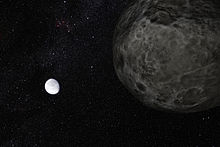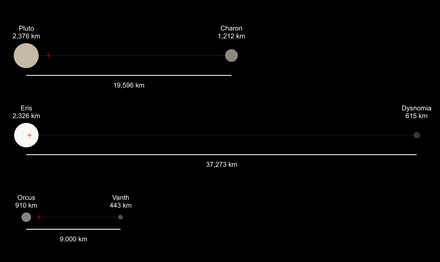Dysnomia (moon)
synchronous[4] | |
| ≈ 0° to orbit (assumed) | |
| Albedo | 0.05±0.01[3]: 7 |
| 25.4[f] | |
| 5.6[f] | |
Dysnomia (formally (136199) Eris I Dysnomia) is the only known
With an estimated diameter of 615+60
−50 km, Dysnomia spans 24% to 29% of Eris's diameter. It is significantly less massive than Eris, with a density consistent with it being mainly composed of ice.[3]: 8 In stark contrast to Eris's highly-reflective icy surface, Dysnomia has a very dark surface that reflects 5% of incoming visible light,[3] resembling typical trans-Neptunian objects around Dysnomia's size.[7] These physical properties indicate Dysnomia likely formed from a large impact on Eris, in a similar manner to other binary dwarf planet systems like Pluto and Orcus, and as well as the Earth–Moon system.
Discovery
In 2005, the
Physical characteristics

−50 km (24% to 29% of Eris's diameter) and an albedo of 0.05±0.01.[3] Of the known moons of dwarf planets, only Charon is larger, making Dysnomia the second-largest moon of a dwarf planet.[10] Dysnomia's low albedo significantly contrasts with Eris's extremely high albedo of 0.96; its surface has been described to be darker than coal,[10] which is a typical characteristic seen in trans-Neptunian objects around Dysnomia's size.[7]
Eris and Dysnomia are mutually
The brightness difference between Dysnomia and Eris decreases with longer and redder wavelengths; Hubble Space Telescope observations show that Dysnomia is 500 times fainter than Eris (6.70-magnitude difference) in visible light,
Orbit

Combining Keck and Hubble observations, the orbit of Dysnomia was used to determine the mass of Eris through Kepler's third law of planetary motion. Dysnomia's average orbital distance from Eris is approximately 37,300 km (23,200 mi), with a calculated orbital period of 15.786 days, or approximately half a month.[2] This shows that the mass of Eris is 1.27 times that of Pluto.[15][16] Extensive observations by Hubble indicate that Dysnomia has a nearly circular orbit around Eris, with a low orbital eccentricity of 0.0062±0.0010. Over the course of Dysnomia's orbit, its distance from Eris varies by 462 ± 105 km (287 ± 65 mi) due to its slightly eccentric orbit.[2]
Dynamical simulations of Dysnomia suggest that its orbit should have completely circularized through mutual tidal interactions with Eris within timescales of 5–17 million years, regardless of the moon's density. A non-zero eccentricity would thus mean that Dysnomia's orbit is being perturbed, possibly due to the presence of an additional inner satellite of Eris. However, it is possible that the measured eccentricity is not real, but due to interference of the measurements by albedo features, or systematic errors.[2]
From Hubble observations from 2005 to 2018, the inclination of Dysnomia's orbit with respect to Eris's
Formation
Eight of the ten largest trans-Neptunian objects are known to have at least one satellite. Among the fainter members of the trans-Neptunian population, only about 10% are known to have satellites.
Name
Mike Brown, the moon's discoverer, chose the name Dysnomia for the moon. As the daughter of Eris, the mythological
A primary reason for the name was its similarity to the name of Brown's wife, Diane, following a pattern established with Pluto. Pluto owes its name in part to its first two letters, which form the initials of
Notes
- ^ Full list of discoverers are Michael E. Brown, M. A. van Dam, A. H. Bouchez, D. Le Mignant, R. D. Campbell, J. C. Y. Chin, A. Conrad, S. K. Hartman, E. M. Johansson, R. E. Lafon, D. L. Rabinowitz, P. J. Stomski Jr., D. M. Summers, C. A. Trujillo, and P. L. Wizinowich.
- ^ Brown uses the latter pronunciation.[1]56m
- ^ The orbital period (P) is 15.774 d. The orbital circumference (C) is 2π*semi-major axis. Dividing these (P/C) using the correct units gives 0.172 km/s.
- ecliptic latitude of +28.41°±0.16°,[2]: 5 subtracting this angle from the ecliptic north pole of +90° gives the inclination with respect to the ecliptic: i = +90° – (+28.41°) = +61.59°.
- ascending node and argument of periapsis, so subtracting Dysnomia's ascending node of 126.17°±0.26° from its longitude of periapsis gives 180.83° for its argument of periapsis.
- ^ a b Dysnomia's brightness is 1/500 of Eris in the visible band. With H = −1.19 for Eris and a magnitude difference of Δm = 6.70, this gives H ≈ 5.6 for Dysnomia.[5]
References
- ^ a b
Brown, M. E.; et al. (2006). "Satellites of the Largest Kuiper Belt Objects" (PDF). S2CID 2578831. Retrieved 19 October 2011.
- ^ a b c d e f g
Holler, Bryan J.; Grundy, William M.; Buie, Marc W.; Noll, Keith S. (February 2021). "The Eris/Dysnomia system I: The orbit of Dysnomia". Icarus. 355: 114130. S2CID 221995416. 114130.
- ^ .
- ^ S2CID 253522934.
- ^ a b Grundy, Will (21 March 2022). "Eris and Dysnomia (136199 2003 UB313)". Lowell Observatory. Retrieved 16 November 2022.
- ^
Green, D. W. E. (13 September 2006). "(134340) Pluto, (136199) Eris, and (136199) Eris I (Dysnomia)". Bibcode:2006IAUC.8747....1G. Retrieved 12 January 2012.
- ^ S2CID 119343798. 164.
- ^ Zabarenko, D. (3 October 2005). "Planet Xena has moon called Gabrielle". Australian Broadcasting Corporation. Retrieved 9 March 2008.
- ^ Ingham, R. (2 February 2006). "'Tenth planet' Xena bigger than Pluto". Australian Broadcasting Corporation. Retrieved 9 March 2008.
- ^ a b Lakdawalla, Emily (25 January 2018). "Some big moons in the Kuiper belt". The Planetary Society.
- S2CID 126574999. Archived from the originalon 7 April 2019.
- ^
Brown, M. E. (14 June 2007). "Dysnomia, the moon of Eris". Caltech. Retrieved 3 July 2011.
- ^ Green, D. W. E. (4 October 2005). "S/2005 (2003 UB313) 1". IAU Circular. 8610. Retrieved 12 January 2012.
- ^
Sicardy, B.; et al. (2011). "A Pluto-like radius and a high albedo for the dwarf planet Eris from an occultation" (PDF). S2CID 4422527.
- ^
Brown, M. E.; Schaller, E. L. (2007). "The Mass of Dwarf Planet Eris". S2CID 21468196.
- ^
Brown, M. E.; Schaller, E. L. (2007). "Supporting Online Material for The Mass of Dwarf Planet Eris". Science. 316 (5831): 1585. S2CID 21468196. Retrieved 2 February 2019.
- ^ Mike Brown (2012) How I Killed Pluto and Why It Had It Coming, p. 239
- ^ Tytell, D. (14 September 2006). "All Hail Eris and Dysnomia". Sky & Telescope. Archived from the original on 19 October 2006. Retrieved 30 December 2006.
External links
 Media related to Dysnomia at Wikimedia Commons
Media related to Dysnomia at Wikimedia Commons




